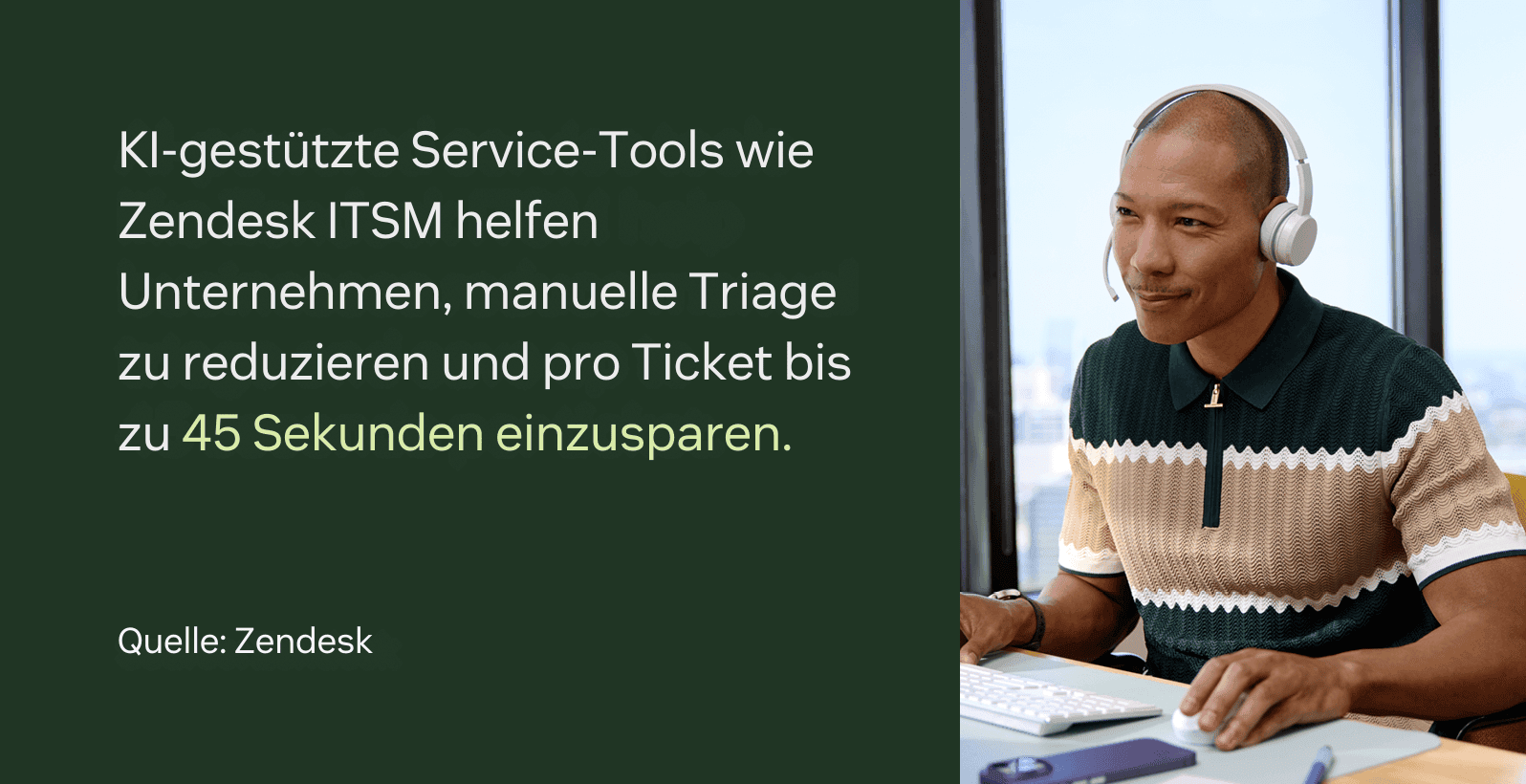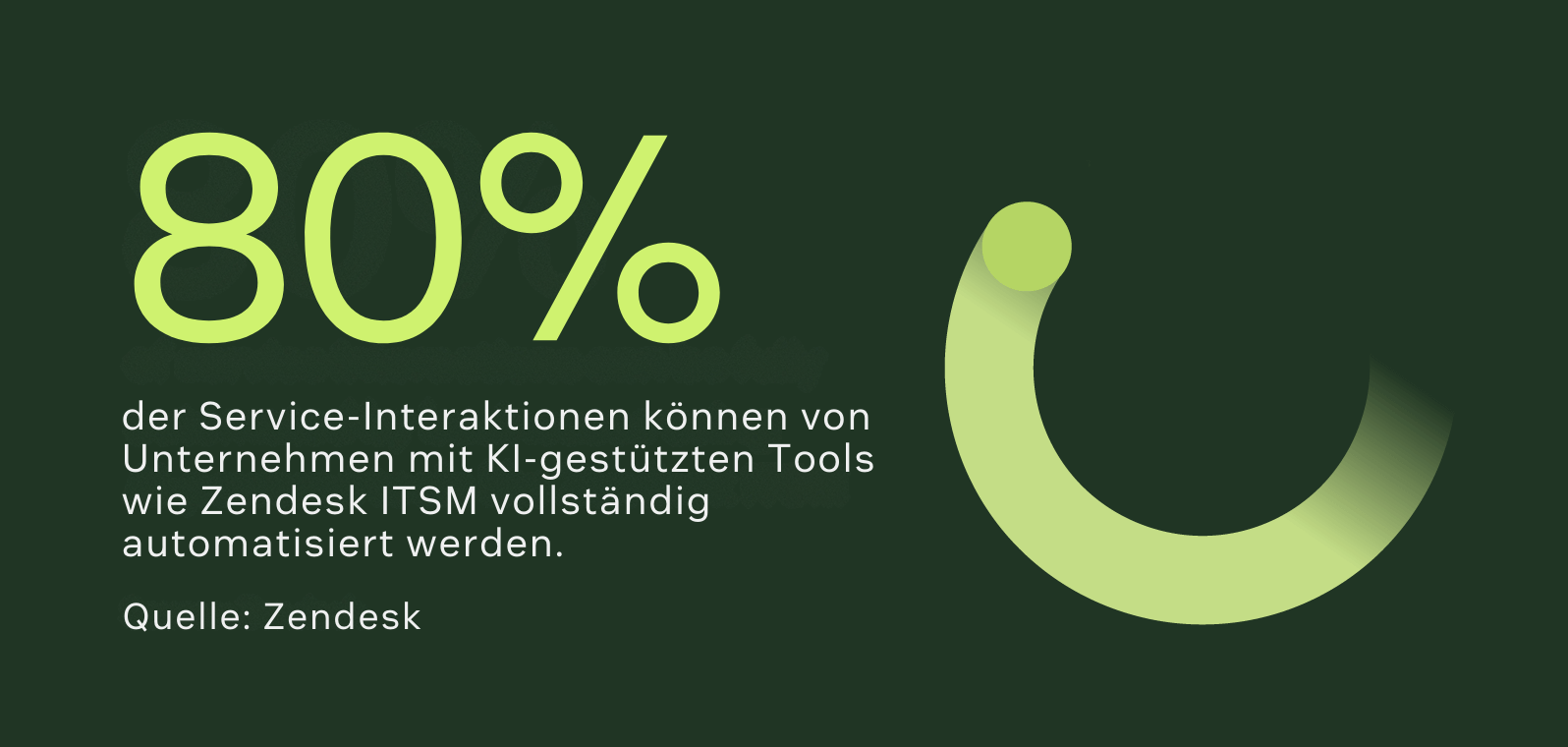Beitrag • 5 Min. Lesezeit
ITSM vs. ESM: Wichtige Gemeinsamkeiten und Unterschiede
Zuletzt aktualisiert: 21. August 2025
Die Bewertung von Tools für das Mitarbeiterservice-Management kann eine Debatte zwischen ITSM vs. ESM auslösen, da Unternehmen die individuellen Erlebnisse ihrer Mitarbeiter:innen optimieren möchten. Beide Ansätze verfolgen das Ziel, die Servicebereitstellung zu vereinfachen und die Effizienz der Teams zu steigern, sie dienen jedoch unterschiedlichen Bereichen und Zwecken.
Diese Unterschiede zu verstehen, ist entscheidend, um eine fundierte Entscheidung für eine Lösung zu treffen, die mit Ihren Zielen für die Servicebereitstellung und der Mitarbeiterzufriedenheit übereinstimmt.
Die Wahl zwischen IT- und Enterprise Service Management beeinflusst, wie Ihr Unternehmen alles verwaltet – von Helpdesk-Tickets bis hin zu komplexen abteilungsübergreifenden Workflows. Lesen Sie weiter, um herauszufinden, welche Lösung Ihrem Unternehmen helfen kann, steigenden Erwartungen der Mitarbeiter:innen gerecht zu werden und Ihre Teams für den Erfolg zu positionieren.
Mehr in diesem Leitfaden:
- Was ist IT-Service-Management (ITSM)?
- Was ist Enterprise-Service-Management (ESM)?
- ITSM vs. ESM: Zentrale Gemeinsamkeiten und Unterschiede
- Wie wählt man zwischen einer ITSM- und einer ESM-Lösung?
- Lassen Sie Zendesk Ihr IT-Service-Repertoire erweitern
Was ist IT-Service-Management (ITSM)?
ITSM bezeichnet den strategischen Ansatz, den Unternehmen nutzen, um zu gestalten, bereitzustellen, zu verwalten und zu verbessern, wie ihre Endnutzer IT-Services erhalten. ITSM richtet IT-Services an den Geschäftsanforderungen aus und stellt gleichzeitig konsistente, hochwertige Unterstützung für technologiebezogene Tickets sicher. Nutzt ein ITSM-Tool KI, kann es manuelle Arbeit wie die Ticket-Triage reduzieren, damit Tickets an die am besten qualifizierten und verfügbaren Agent:innen weitergeleitet werden. Zendesk hat festgestellt, dass diese Tools konservativ geschätzt 45 Sekunden pro Ticket einsparen.

Insgesamt stellt ITSM die Rolle der IT-Abteilung in den Mittelpunkt, um verschiedene Abläufe mit Funktionen wie diesen zu unterstützen:
Typischerweise gibt es etablierte Rahmenwerke innerhalb von ITSM, wie die IT Infrastructure Library (ITIL), die Best Practices für das Lebenszyklus-Management von IT-Services bereitstellt. Diese Rahmenwerke leiten Unternehmen durch Prozesse wie Strategieentwicklung, Betrieb und kontinuierliche Verbesserung. Das Hauptziel von ITSM ist es, zuverlässige, kosteneffiziente IT-Services bereitzustellen, die direkt zum Unternehmenswachstum beitragen.
Was ist Enterprise-Service-Management (ESM)?
ESM erweitert die Prinzipien des Service-Managements über die IT-Abteilung hinaus auf alle Servicebereitstellungen innerhalb eines Unternehmens. Während sich ITSM auf IT-spezifische Services konzentriert, verfolgt ein auf ESM ausgerichteter Enterprise-Helpdesk einen ganzheitlichen Ansatz, der unter anderem Folgendes umfasst:
- Human Resource Management (HRM)
Facility-Management
Finanzen
Im Grunde genommen werden alle Abteilungen, die interne Services für Mitarbeiter:innen bereitstellen, in ESM einbezogen. Diese breitere Perspektive erkennt an, dass Mitarbeiter:innen täglich mit mehreren Serviceanbietern interagieren – und jede Interaktion trägt zu ihrem Gesamterlebnis und ihrer Produktivität bei.
ITSM vs. ESM: Zentrale Gemeinsamkeiten und Unterschiede
Der Vergleich von ITSM vs. ESM zeigt viele Gemeinsamkeiten. Obwohl ESM auf denselben Grundprinzipien wie ITSM basiert – etwa standardisierten Prozessen, dem Fokus auf Self-Service und automatisierten Workflows – wendet ESM diese Prinzipien auf die gesamte Organisation an.
Gemeinsamkeiten | Unterschiede |
Prozessorientierter Ansatz: Beide basieren auf standardisierten Workflows, Ticketsystemen und definierten Service Level Agreements (SLAs), um eine konsistente Servicebereitstellung sicherzustellen. | Leistungsumfang: ITSM konzentriert sich ausschließlich auf IT-bezogene Services, während ESM alle internen Servicefunktionen umfasst. |
Self-Service für Mitarbeiter:innen: Beide bieten Benutzerportale für Mitarbeiter:innen, um Anfragen einzureichen, auf Wissensdatenbanken zuzugreifen und den Fortschritt bei der Lösung zu verfolgen. | Organisationsstruktur: ITSM wird innerhalb der IT-Abteilungen umgesetzt, während ESM die unternehmensweite Einführung erfordert. |
Leistungsmessung: Beide nutzen Helpdesk-Metriken, wie Bearbeitungszeiten und Serviceverfügbarkeit, um die Servicequalität zu bewerten und zu verbessern. | Implementierungskomplexität: ITSM kann einfacher in bestehende IT-Rahmenwerke integriert werden, während ESM ein umfassenderes Change-Management und die Zustimmung der Stakeholder erfordert. |
Automatisierungsfokus: Beide können Workflow-Automatisierung, KI-Agenten und intelligente Omnichannel-Routing nutzen, um Effizienz und Benutzererlebnis zu verbessern. | Strategische Ausrichtung: ITSM ist in erster Linie mit der IT-Strategie abgestimmt, während ESM auf die Ziele mehrerer Abteilungen eingehen muss. |
Spannend wird es hier: Diese Unterschiede können sich gegenseitig ergänzen, statt als Opportunitätskosten gegeneinanderzustehen. Ein starkes ITSM kann ESM unterstützen und Mitarbeiter:innen besser darauf vorbereiten, erstklassigen Kundenservice in ihren Rollen zu leisten. Und wenn sowohl Kund:innen als auch Mitarbeiter:innen profitieren, wird die Service-Exzellenz leichter erreicht als je zuvor.
Wie wählt man zwischen einer ITSM- und einer ESM-Lösung?

Die Wahl zwischen ITSM- und ESM-Lösungen erfordert eine sorgfältige Bewertung der Ziele und Ressourcen Ihres Unternehmens. Befolgen Sie diese Schritte, um die richtige Lösung für Ihre spezifischen Anforderungen zu finden.
Bewerten Sie die Reife Ihrer Servicebereitstellung
Unternehmen mit etablierten, ausgereiften ITSM-Praktiken können sich leichter auf ESM ausweiten, während Unternehmen, die ihre ITSM-Fähigkeiten noch entwickeln, zunächst von einer IT-fokussierten Lösung profitieren.
Bewerten Sie Schmerzpunkte und Mitarbeiterfeedback
Wenn sich Beschwerden hauptsächlich auf Ihren IT-Helpdesk beziehen – wie lange Reaktionszeiten oder Systemausfälle – kann eine ITSM-Lösung Ihre unmittelbaren Bedürfnisse erfüllen.
Wenn Mitarbeiter:innen jedoch auch Frustrationen mit HR, IT und anderen Abteilungen äußern, bietet ein ESM-Ansatz die einheitliche Erfahrung, die sie wünschen. Wichtig ist, die Lösung speziell für Mitarbeiter:innen zu entwickeln, um Produktivität zu fördern und veraltete, unhandliche Prozesse zu vermeiden.
Berücksichtigen Sie die Veränderungsbereitschaft
Die Implementierung von ESM erfordert in der Regel umfangreicheres Training und mehr Koordination als eine sofort einsatzfähige ITSM-Lösung wie Zendesk, die für viele Unternehmen realistischer ist.
Diese Tools beschleunigen die Time-to-Value (TTV), da sie es Unternehmen ermöglichen, vom ersten Tag an auf jede Abteilung und jede Komplexität zu skalieren – ohne erfahrene Entwickler:innen zu benötigen.
Priorisieren Sie KI zur Lösungsfindung
Die fortschrittlichsten Service-Management-Tools, wie Zendesk, nutzen KI, um Effizienz und Benutzererlebnis zu steigern. Es handelt sich nicht nur um einen ITSM-Trend – KI-Funktionen wie prädiktive Analysen und intelligente Empfehlungen in der Wissensdatenbank verstärken die Vorteile von ITSM und ESM erheblich, indem sie:
Antwortzeiten verbessern
Proaktive Einblicke liefern
Mitarbeiter:innen Zeit für wichtige Aufgaben freisetzen (und sie von redundanter manueller Arbeit entlasten)
Mit einem Tool wie Zendesk erhalten Sie KI, die auf Milliarden realer Serviceinteraktionen vortrainiert ist – für präzisen, effizienten Service, der bis zu 80 Prozent der Interaktionen vollständig automatisieren kann.
Definieren Sie Ihre langfristige Strategie
Unternehmen, die eine umfassende Transformation anstreben, finden oft, dass ESM besser zu ihren Zielen passt – auch wenn die Einführung länger dauert. Wer sich auf spezifische IT-Service-Verbesserungen konzentriert, erzielt durch gezielte Investitionen schneller eine Rendite (ROI), die die Servicebereitstellung im IT-Helpdesk verbessert.
Letztlich ist dies keine endgültige Entscheidung. Viele erfolgreiche Unternehmen kombinieren ITSM und erweitertes ESM, je nach Entwicklung ihrer Fähigkeiten und organisatorischen Reife.
Transformieren Sie Ihr IT-Service-Erlebnis mit den skalierbaren, KI-gestützten Tools von Zendesk
Ob Ihr Unternehmen bereit ist, fokussierte ITSM-Lösungen einzuführen oder umfassende ESM-Fähigkeiten zu implementieren – die Grundlage bleibt dieselbe: herausragende Serviceerlebnisse in großem Umfang bereitzustellen, die Ihre Mitarbeiter:innen stärken und den Erfolg vorantreiben.
Die flexible, KI-gestützte Helpdesk-Software von Zendesk wächst mit Ihren Ambitionen. Sie bietet herausragende Skalierbarkeit und Anpassungsfähigkeit, sodass Sie mit IT-fokussierten Implementierungen beginnen und im Laufe der Zeit auf unternehmensweite Servicebereitstellung erweitern können. Mit intuitiven Oberflächen, leistungsstarker Automatisierung sowie umfassendem Reporting und Analytics hilft Zendesk Ihnen, nahtlose Serviceerlebnisse für Ihre Mitarbeiter:innen zu schaffen – und liefert gleichzeitig KI-gestützte Einblicke, um kontinuierliche Verbesserungen zu ermöglichen.
Entdecken Sie, wie Zendesk Ihren Ansatz für Service-Management mit einer kostenlosen Testversion transformieren kann.
